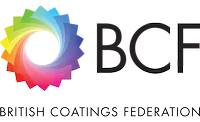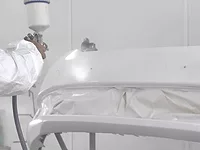No Fear of Scratches





Automotive paints have to withstand a lot – whether it is dirt, road salt or UV radiation. The coatings protect a car’s body against mechanical and environmental influences, and also serve an important optical purpose. Most of today’s automotive coatings are comprised of four paint layers. The topmost layer – the clearcoat, which is about 40 micrometers thick – is crucial to a car’s visual presentation. For design reasons, the clearcoat has to be transparent and shiny, but also strong and flexible so it does not splinter when impacted by foreign objects.
Modern polyurethane-based two-pack clearcoats are remarkably resistant to chemical influences. Automobile manufacturers are using clearcoats with improved scratch resistance, particularly beginning with upper midrange vehicles. This is done in an attempt to meet customer demands, as well as reduce the cost of maintaining vehicle fleets and leased vehicles for resale.
Over time, however, and with regular visits to the car wash, brushes, as well as dust and dirt, leave behind visible micro-scratches in these clearcoats. This is why a clearcoat may lose its shine over the years. Even today, coatings that are labeled as “scratch-resistant” and are formulated with nanoparticles only start out as scratch-resistant. The problem is that the binding agent weathers over time, causing particles on the surface of the clearcoat to be washed out by brushes and cleaners, which means scratches will occur.
New Binder Technology
For over 30 years, scientific literature has shown that silane-modified resins can significantly improve the properties of adhesives and coatings. But a key component of these resins is difficult to produce in high yields on an industrial scale, which has a noticeable impact on the price. This is why the technology is currently limited to niche applications, such as high-performance adhesives. When it comes to automotive clearcoats, which are far more price-sensitive, silane-modified resins had not even been considered until now.
Evonik’s Crosslinkers Business Line of the Coatings & Additives Business Unit has developed a technology platform that can be used to significantly improve the scratch resistance of clearcoats. For developing this VESTANAT®EP-M family of products, they received the Evonik Innovation Award 2013 in the New Products/New System Solutions category. Clearcoats based on this new technology stand up to chemicals and weather as well as the conventional two-pack polyurethane coatings.
With the goal of producing industrially relevant quantities at competitive prices, and with the involvement of multiple business units, the participants in this project researched and tested the technology’s potential for coating formulations, and developed a process for manufacturing the coating resin. This included finding suitable catalyst systems. The development work covered vast sections of the entire value-added chain, including a coatings formulator and an automobile manufacturer. The team networked and used the Group’s existing expertise in silane chemistry and isocyanate production processes. Intensive and cooperative collaboration with the Functional Silanes Business was a major contributing factor to the success of the project.
The key component in the production of urethane-modified poly(alkoxysilane) is a silylisocyanate, 3-isocyanatopropyltrimethoxysilane (IPMS). With one silane and one isocyanate group, the molecule is bifunctional and particularly well-suited to crosslinking (Figure 1). In producing this silane-modified isocyanate, it was important to master a phosgene-free production process. Such a process prevents the simultaneous destruction of the sensitive silane at the other end of the molecule when the isocyanate group is chemically synthesized – improving yield distinctively.
Evonik has since filed patent applications for the innovative crosslinking concepts and the new catalyst concepts. The IPMS has been produced on an industrial scale at a new plant at the Marl, Germany, site since June 2013.
Testing
Based on tests commonly used in the automotive industry, this key component for innovative resins can significantly improve the scratch resistance and gloss retention of clearcoats (Figure 2). Tests conducted on the carwash resistance of coatings with the new coating binders from Evonik show that the coatings permanently retain their scratch resistance. Even after 1,000 and 1,500 hours of accelerated weathering, these coatings can hold up to 80-90% of their original gloss in the test. The standard for scratch resistance (in gray) is still only a little over 70%. The reason for the improved scratch resistance is the higher crosslinking density that, at the same time, allows the clearcoat to be highly flexible, and also allows the formation of hard, SiO2-like areas solidly integrated into the coating matrix –comparable to quartz.
Figure 3 shows the stresses that coated surfaces undergo in car washes, as simulated realistically in the Amtec laboratory car wash facility. Test panels were moved back and forth under horizontally rotating washing brushes. The contact pressure was adjustable. To simulate the surface contamination, a fixed quantity of quartz powder was mixed with the cleaning water.
Figure 4 shows scratches on the surface of a standard automotive clearcoat created in the car wash simulation test as seen under a scanning electron microscope.
Figure 5 shows coated panels after a scratch test (wet). On the left is the control panel, and on the right, a test panel coated with a polysilane-based clearcoat.
Tests also proved that clearcoats based on the new technology stand up to chemical and weather exposure as well as conventional two-pack polyurethane coatings. Another advantage is that the new materials are a relatively simple matter for customers, because only fine-tuning is required to integrate them into established coating formulations. The technology is fully compatible with conventional two-pack polyurethane coatings. For a car manufacturer, this means coatings with the new resin can be easily applied in existing production lines.
Custom-Designed Solutions
With this new technology, the flexibility, chemical resistance, adhesion and surface energy of coatings, as well as their solubility in solvents, can be adjusted by selecting particular organic crosslinkers. The processing window can also be set by combining various resins and catalysts within a wide range of temperatures, from ambient temperature to 160 °C. This provides a toolbox that can be used to design a customized solution for each application. So IPMS provides the basis for members of an entire product family. In addition to clearcoats for the automotive industry, the technology could also be used for a host of other applications that would benefit from extreme scratch resistance for aesthetic or functional reasons.
Evonik does not supply IPMS as a building block for resins to coatings manufacturers because this material would be difficult to store and, above all, handle. Instead, customer-specific resins, named VESTANAT EP-M, are supplied to customers.
Conclusion
Clearcoats based on this new binder technology are now on their way to being approved by selected automobile manufacturers. A manager at one facility has indicated that the silane technology could become the standard for clearcoats of premium vehicles at his company in the next few years.
For more information, contact Markus.hallack@evonik.com.
Looking for a reprint of this article?
From high-res PDFs to custom plaques, order your copy today!








